
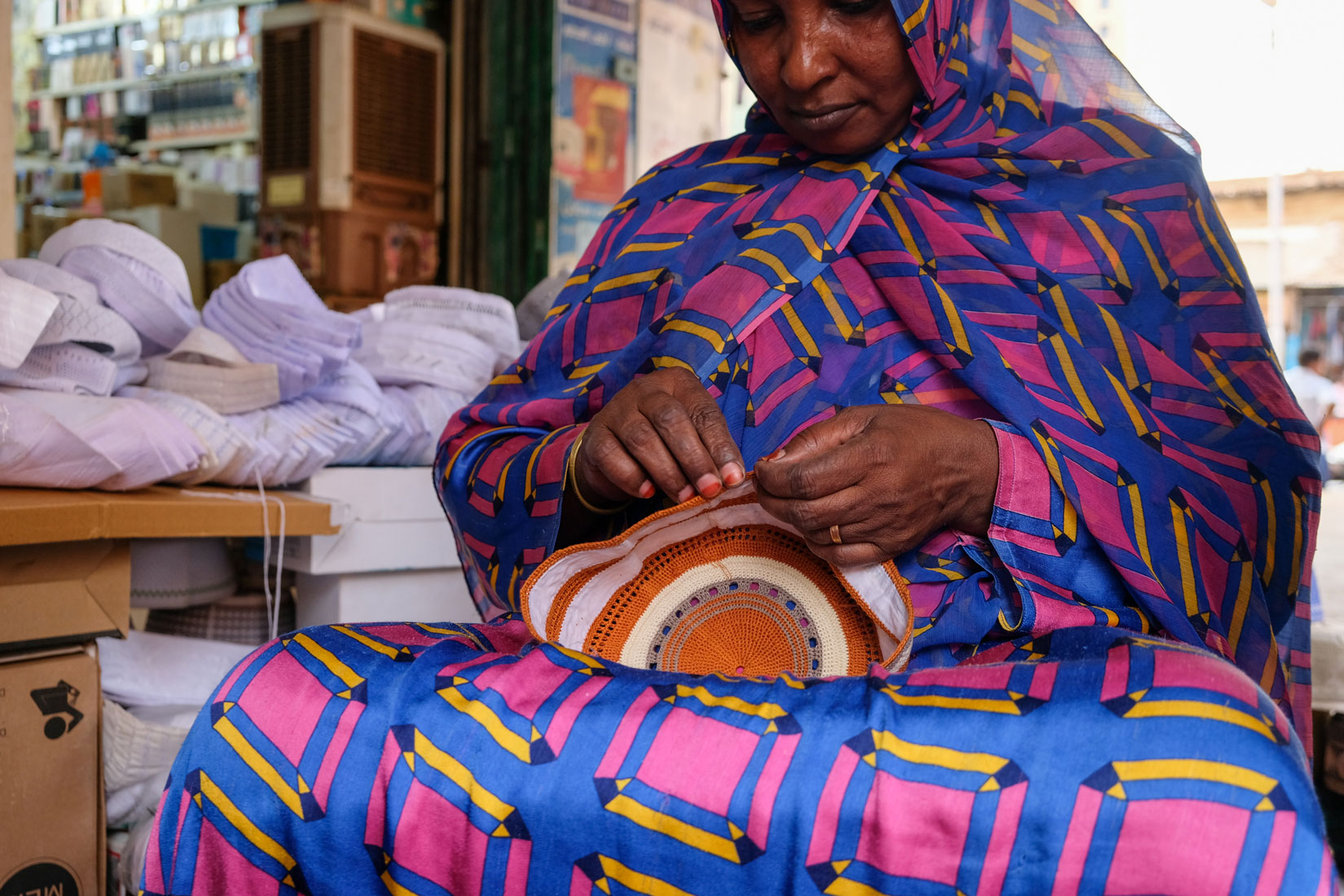
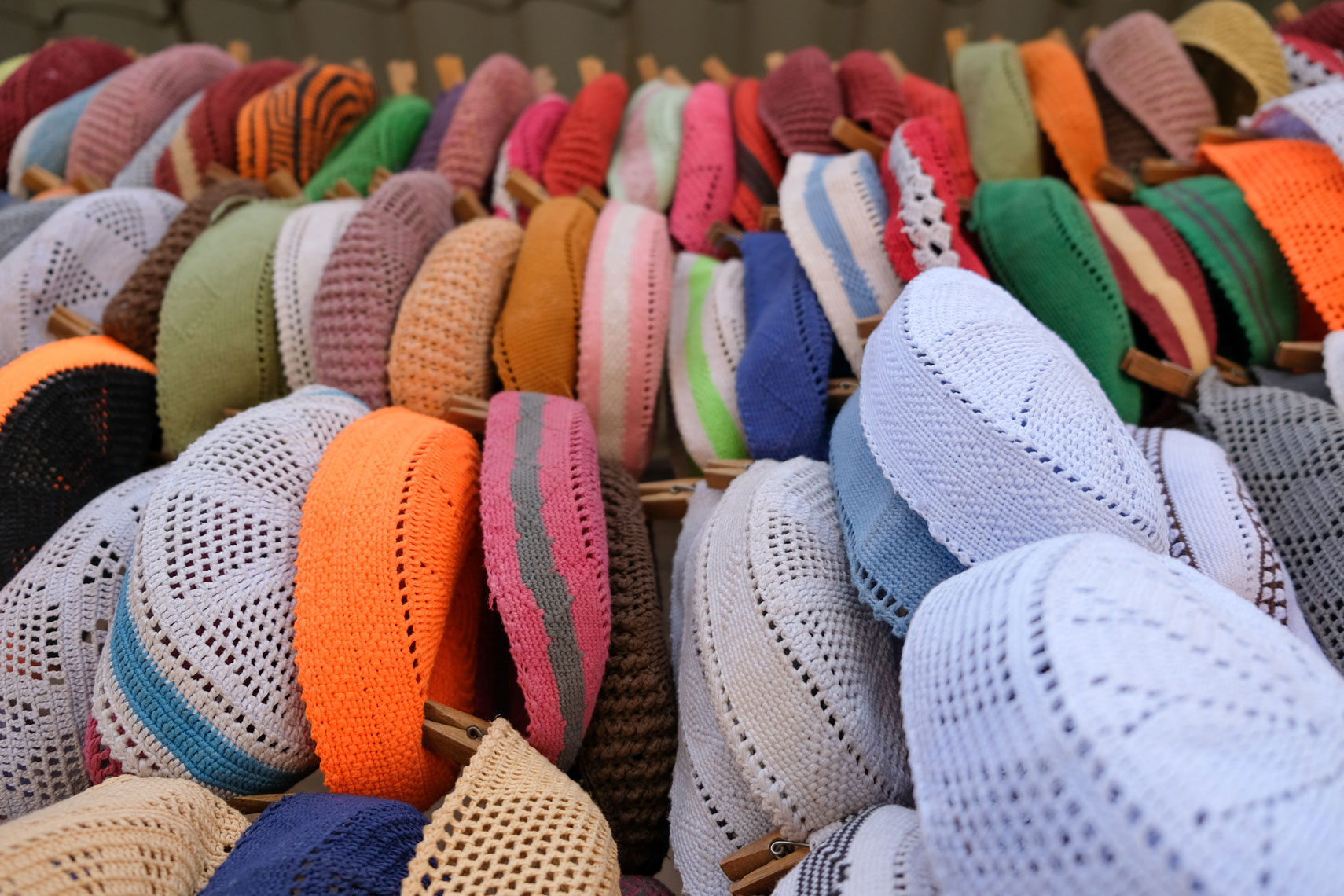
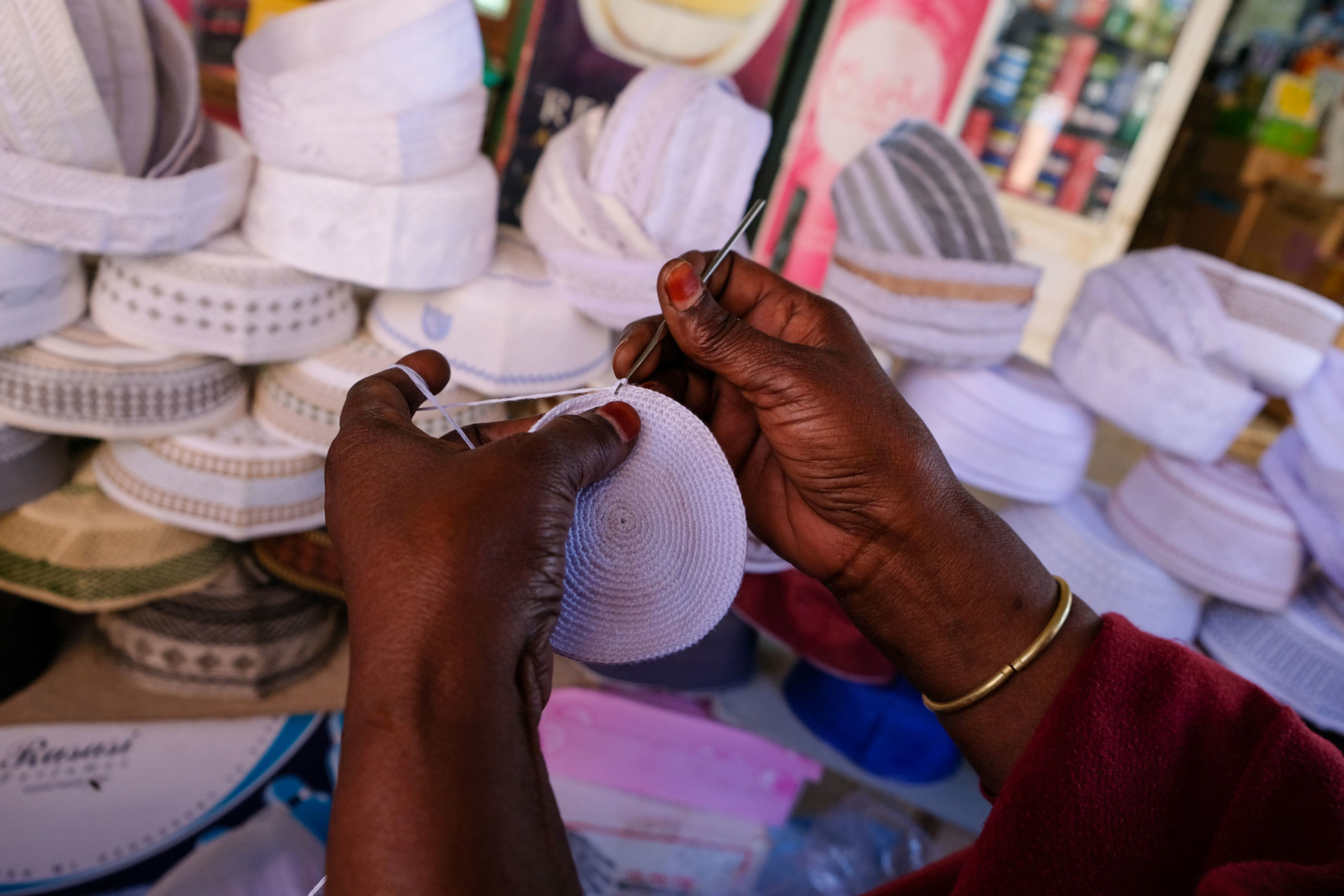
Khartoum’s Handmade Skull Caps
A Vanishing Craft: Khartoum’s Handmade Skull Caps
Sudan is the last redoubt of individual craftspeople in what has become a mass-produced item
In the middle of central Khartoum, right near the city’s majestic terracotta brick mosque, are several market streets sprawling out in every direction. Vendors sell phones and shoes; people walk in and out of the small offices, pharmacies and shops. One street, busy since early morning, has a row of stalls run by women. They all display the same thing: soft, round skull caps, varying in shape and color, crocheted and embroidered.
Suddenly, a man in a cotton shirt stops in front of a stall. He picks up a hat and puts it on his head. The woman behind the stall hands him a small mirror. He takes a look, adjusts the hat slightly with one hand, then reaches for his money with the other.
“It’s impossible to find these in Turkey where I live. I work at the Sudanese Embassy there. I’m flying back tonight and want to bring some hats with me,” he says. “People in Turkey there don’t wear these, not like we do here in Sudan. And there’s nowhere to buy handmade hats.”
True. Handmade “taqiyas,” or “topis,” are not easy to find. Variants of the small, round hats are worn across many parts of the world, including the Middle East, the Indian subcontinent and parts of Africa and Southeast Asia. For many Muslims, they have a religious connotation: It was the practice of the Prophet Muhammad to cover his head, and many see this as an example to follow. For others, the skull cap is just a piece of clothing like any other. In the past, before mass production prevailed and many handmade crafts diminished, hats were always made by hand. But these days, in most countries, handmade caps are hard to find — except here in Sudan.
Today, some of Sudan’s best taqiyas come from the Darfur region, where places like Nyala and Jebel Murra are known for their fine stitching traditions. Because of the conflict in Darfur, many craftspeople have been displaced and now live and work in Khartoum and other cities. Other places with rich crafting traditions are Kordofan, in Sudan’s south, and the eastern regions of Kassala and Gadaref. Many wearers still prefer handmade hats, even though competition from imported and machine-made hats threatens this tradition.
As the man walks away, hat in hand, new customers pass by the stall. Many wear jeans or pants; others are dressed in Sudan’s long and airy jalabiya. Most men in jalabiya also wear a soft hat on their head. In the eyes of many, to be properly dressed, the white robe necessitates a taqiya.
“You don’t walk out in a jalabiya without a taqiya on your head,” says Abu Bakr Mohammad Ibrahim, a driver from Khartoum’s twin city Omdurman. “They go together. And preferably, they should match.”
Across Sudan, a large number of craftspeople, mostly women, make taqiyas in a range of different local styles. Most use yarn to crochet their hats; others stitch them from pieces of soft cotton. White is the favored color, but reds, greens and browns — even pinks — are not uncommon. Many artisans have their stalls in markets or shopping areas in Sudan’s towns and cities, which always have a small section dedicated to taqiyas.
“If you pick up a hat, you know immediately what region it is from. Darfur, Kordofan, Kassala or Gadaref all have their own unique designs,” says Al Sunna Safia, a craftsperson who has a stall on another street near the mosque.
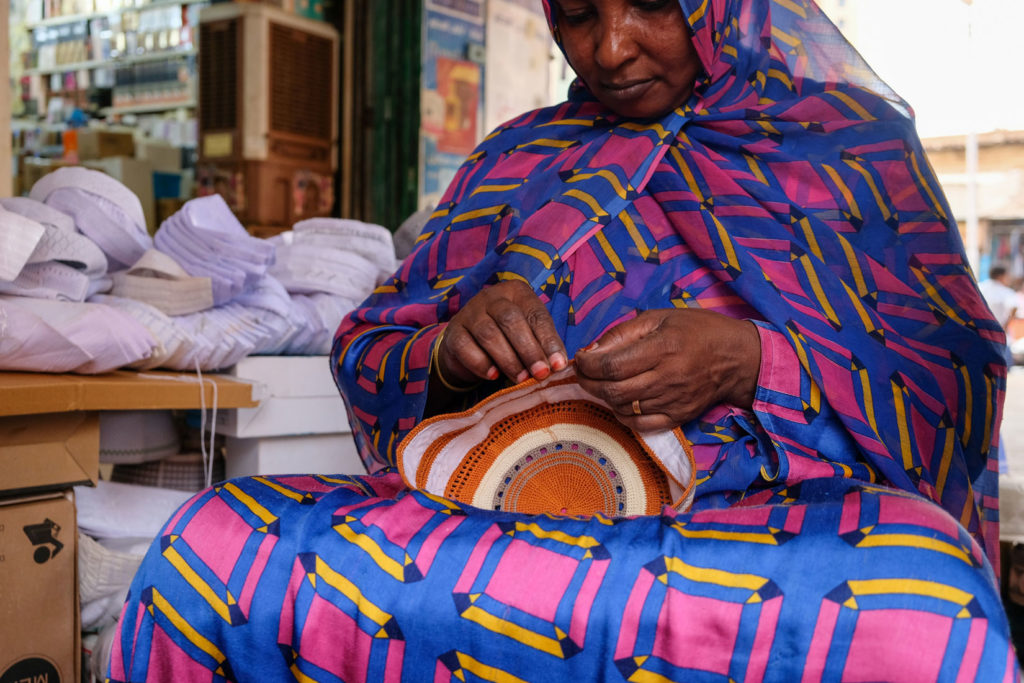
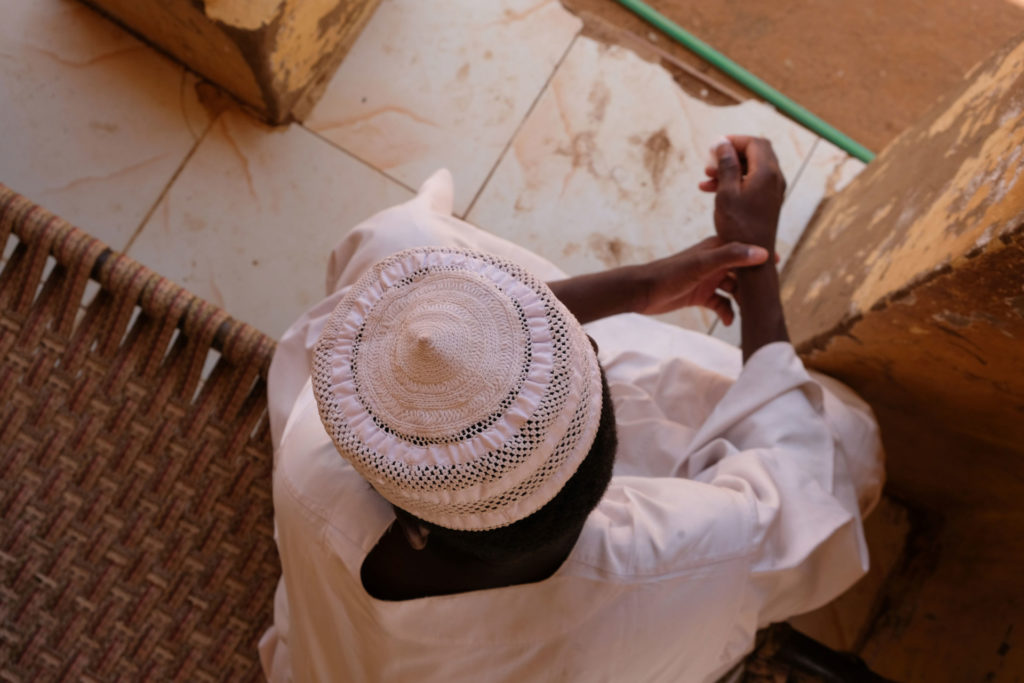
Safia has placed empty cardboard boxes in a semicircle outside a small perfume and fragrance shop and displays her taqiyas on top. There are soft caps in white crochet and sturdy cotton hats stacked on top of one another. A handful of finely crocheted taqiyas in muted colors, typical of the southern region of Kordofan, are carefully placed in the middle; next to them are plain and simple hats in white or beige, inspired by the style of the Arabian Peninsula, and popular all over the country.
“Sudan has a fine taqiya tradition that dates back long in time,” said Griselda El Tayib, an expert on Sudanese folklore and author of the book “Regional Folk Costumes of the Sudan,” before she passed away in May at the age of 97 years.
She is seated in the living room of her Khartoum villa, on a street named after her late husband, the acclaimed scholar Abdalla El Tayib. Talking about the craft makes her remember things from their life together: Ramadan gatherings hosted by Morocco’s late King Hassan II, Soviet-era trips from Moscow to Tashkent, boat trips to the Seychelles, lecturing at universities in Fes and northern Nigeria.
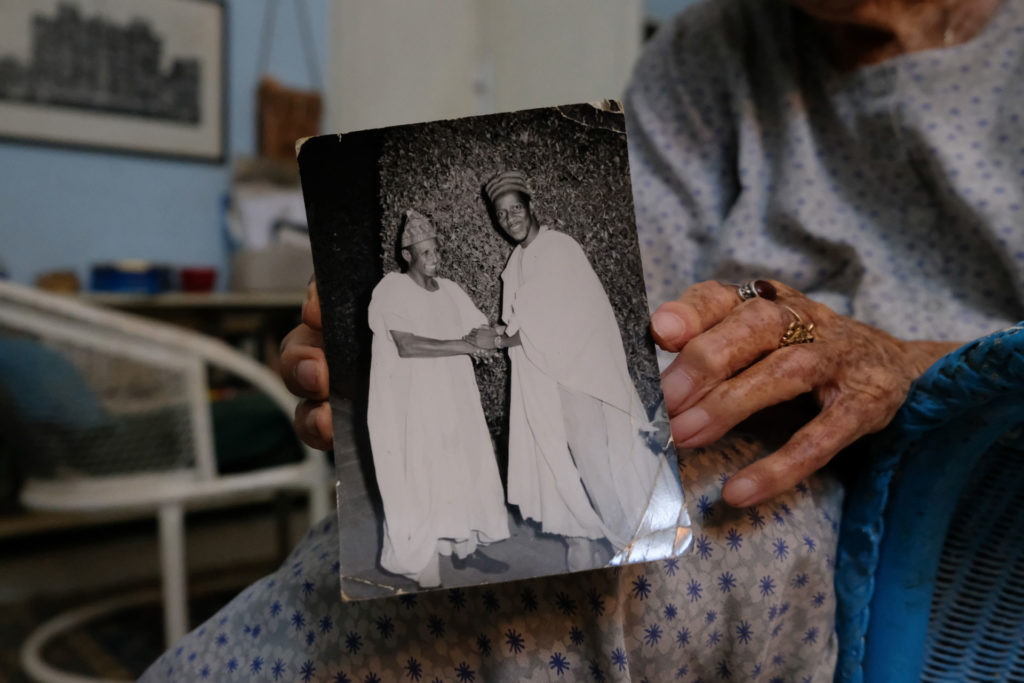
Nigeria, she says, has some of the best skull caps, or “kufis,” as they are called in many parts of Africa. She opens a wardrobe and takes out a few hats carefully wrapped in a bag. One is an Uzbek “doppi,” a sturdy black hat decorated with white-embroidered peppers, meant to bring luck to the wearer. Another is a cylindrical hat with thick, green-and-black stitches.
“This one is from Nigeria,” Griselda says. “It was the last hat my husband wore. It still has his smell.”
Across the world, versions of the skull cap are as many as the regions in which they are found. In Central Asia, both men and women wear the doppi, or “tubeteika” as it is called in Russian. Some feature colorful floral cross-stitch; others are decorated all in white. Many Uzbek designs have a symbolic meaning — the ram’s horn or fish for virility and fertility, scorpions for protection and sunflowers signifying the sun. The Uyghur skull cap has taken on added cultural and political importance because of the Chinese government’s persecution, and since 2012, Doppa Day is celebrated annually around the world to protect Uyghur heritage.
In the Arab world, several regions have their own distinctive styles. The Saudi Arabian oasis town of Al Ahsa has a specific taqiya decorated with golden embroidered coins, which was once sold to wealthy buyers all over the country. Tunisia has its red woollen “chechia,” resembling the Ottoman fez, which is rarely worn these days but still made and sold at a dedicated section in Tunis’ old market. The Omani “kumma” is particularly elaborate, with a white background and geometrical and floral motifs. Most are machine-stitched today, but traditional kummas are hand-embroidered using a technique known as “tanjeem,” which comes from the word for star, “najm.”
In South Asia, the Sindh region in eastern Pakistan and northwestern India is known for its intricate embroidery and has a colorful “topi” embellished with tiny mirrors and a decorative arch cut out in front. Historically, craftspeople would always work with whatever material was available locally. Sabir Ahamed, a researcher from Kolkata, recalls topis being made from palm leaves during his childhood. A Karachi photographer, Bilal Hassan, says that his grandfather once had a soft and warm topi made from sheep fleece. “But you don’t get that stuff anymore,” he laments.
While mainly associated with the Islamic faith and aesthetics, skull caps are worn across belief systems and traditions. Kenya’s anti-colonial activist and first premier, Jomo Kenyatta, often wore a cylindrical kufi; the leader of Indonesia’s independence movement, Sukarno, was hardly ever seen without a black “songkok” or “peci.” The kippahs worn by Jews from Uzbekistan’s ancient Silk Road city Bukhara are remarkably similar in design to local doppis. Orthodox and Catholic clergy alike wear prayer caps, often in simple designs. Depending on rank, Catholic priests may wear hats in black, white, red or bright purple. When Pope John Paul II died in 2005, the tailor that served him placed a single white skull cap in their shop window as a tribute.
In Sudan, a cotton-growing nation, some of the oldest taqiyas were made from thin strips of cotton stitched together to form a round hat. Perhaps the simplest kind, hardly worn today and often made of repurposed yarn, is aptly called “al falasiya,” or bankruptcy. Griselda describes another traditional style, “al mansaj,” named after the wooden frame on which artisans stretched out and embroidered their fabric.
Across the Nile from Khartoum is Omdurman, home to one of Africa’s biggest markets. An extensive network of streets and alleys lead to sections dedicated to household items, food or clothes. At one end of the market, near the central green-façade mosque, is an area dedicated to selling taqiyas. Next to a newspaper vendor and a man selling sesame sweets sits Hawa, a woman originally from Darfur.
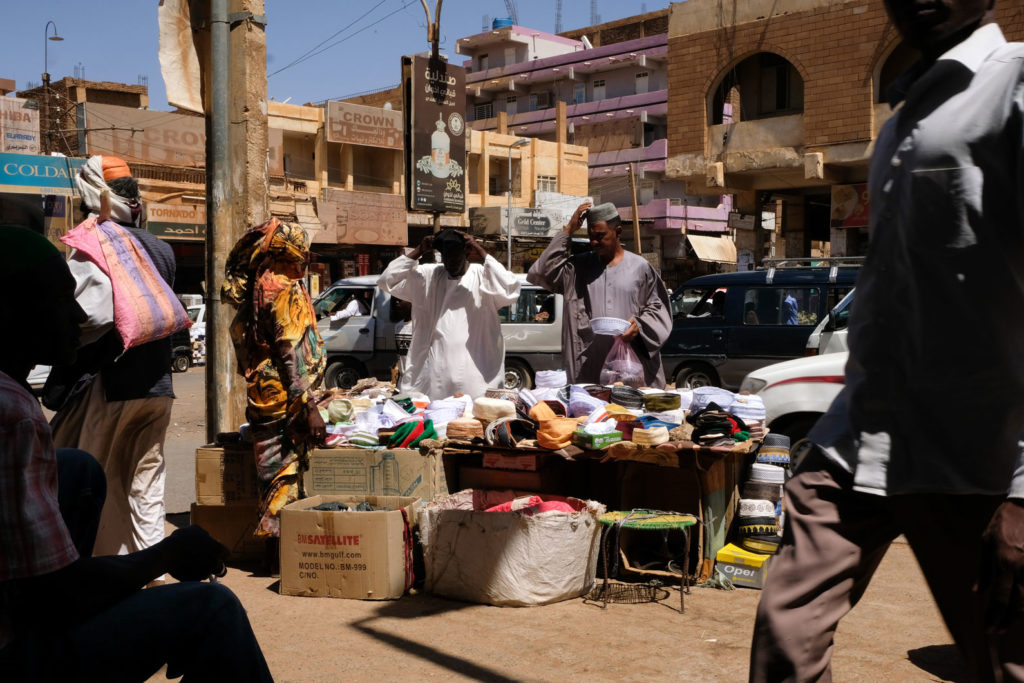
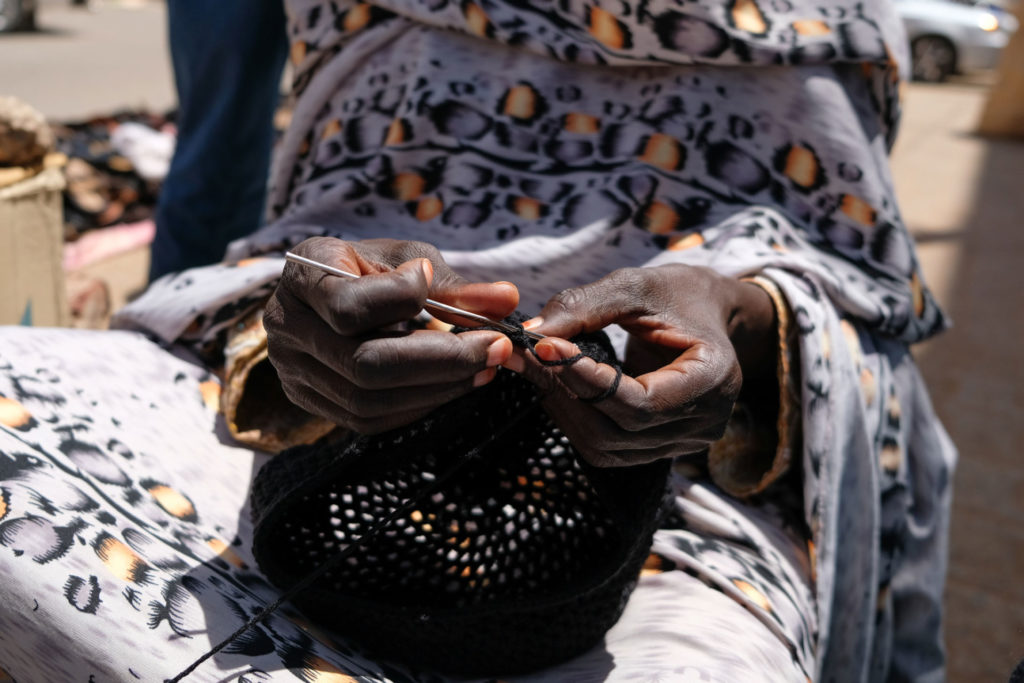
“I come here every day except Fridays. I come in the morning and leave before it gets dark,” she says.
In her lap is a half-finished hat made from black yarn and a thread that disappears into a plastic bag by her feet. She holds a crochet hook in one hand and the thread wound around the first finger of her other. With ease, she adds stitch after stitch to a concentric circle, which eventually will grow to perfectly fit the size of a head.
“I learned this craft as a girl. I can’t remember exactly when, but I was young. We all learned from our grandmothers and mothers at the time,” Hawa says.
The taqiya in her lap is different from those sold by Safia and many other women: This is a loose-fit hat for someone with dreadlocks. Hawa points to a collection of hats in the Rastafarian trio of red-yellow-green and explains that they are easier and quicker to make. Cheaper for the buyer, as well. The price of a taqiya is determined by how long it takes to make.
“We have raised our prices now because of the economic crisis; we had to do that. Hats that used to be 300 pounds [65 cents] are now 1,000 pounds [$2.20] or more,” Hawa says.
On the other side of the street is the stop for buses traveling across the Nile, all the way to the capital’s central market and Safia’s stand. It is a breezy afternoon in Khartoum, and the wind catches some of Safia’s hats on display, throwing them on the ground. A few cylindrical hats with machine-stitched embroidery and labels that read “Made in Bangladesh” roll around on the sidewalk. They are mass-produced copies of the original craft, imported and sold for much less than the handmade hats.
Safia picks them up, one by one, and returns to her chair. Then, two men walking past stop and start looking at the hats on display. One of them picks up a machine-embroidered hat, puts it on his head and thinks for a second. Then he asks for the price, takes out a few bills — the equivalent of less than one U.S. dollar — pays Safia and leaves.
But soon enough, he turns around and comes back to the stall. He puts down the taqiya, takes another hat — this time a crocheted one from Kordofan, with neat brown and beige decor — and places it on his head. He walks away, but Safia calls out after him.
“No, come back. The price is not the same. That one is handmade and costs more!”
Hearing the new price, the man stops to think for a split second. Then, he returns the handmade hat, picks up the first one again and leaves. As he walks away, Safia says nothing and just shrugs her shoulders.


